This is an excerpt from our forth-coming massive sequel to the Biohacker's Handbook called the Resilient Being. You can pre-order it here!
Adaptogens or adaptogenic compounds (derived from the Russian word adaptatsija) refer to a term first defined by Soviet physician and researcher Nikolai Lazarev in 1947. These terms are used to refer to herbs, drugs, or other compounds that increase the ability to adapt to biological, physical, stressors while promoting normal balanced functioning of the body.
Later in the 21st century, the definition was updated to be even more comprehensive:
Adaptogen is a substance that increases the body's ability to adapt to internal and external stress by strengthening the function of the immune system, nervous system, and endocrine glands.
Introduction
Adaptogens enhance resistance to stress, disease, and environmental stressors, and normalize and enhance metabolic function. They are regulators of the biological response that support the body's balance or homeostasis. The effects of adaptogens have been studied in the Soviet Union and Russia since the 1950s. In the West, research became more widespread only in the 21st century. The number of published studies has grown exponentially over the last two decades.
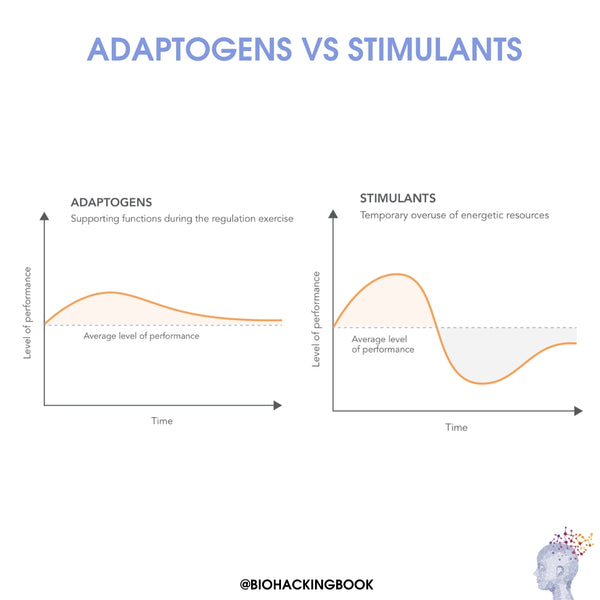
Image: Adaptogens vs. stimulants.
Source: Panossian, A. & Wikman, G. & Wagner, H. (1999). Plant adaptogens III. Earlier and more recent aspects and concepts on their mode of action. Phytomedicine 6 (4): 287–300.
Physiological effects of adaptogens
The term Adaptogen is generally informal and contradictory and does not sit by its multifaceted definition in a medical consensus-based receptor theory that describes the mechanisms of action of drugs. Allostasis means stress homeostasis, i.e. the regulation of stress by the body's adaptive stress management systems.
At the physiological level, adaptogens support the body's homeostasis and balance the function of the nervous system and endocrine glands via the HPA axis. Targeted agents include stress-related mediators such as cortisol, neuropeptide Y, and nitric oxide (NO), as well as G-protein-coupled receptors at the cellular level (such as cAMP, which mediates the effects of adrenaline in cells), stress-activated protein kinase JNK (MAPK-9), heat shock factor 1 (HSF-1), stress proteins (including Hsp72) and the FoxO / DAF-16 transcription factor.
Top 5 Adaptogenic Herbs
Here are the top 5 adaptogenic herbs that can immensely benefit your stress tolerance and increase overall resilience. The other 5+ adaptogenic herbs are covered more in detail in the Resilient Being Book.
1. Roseroot (Rhodiola rosea)
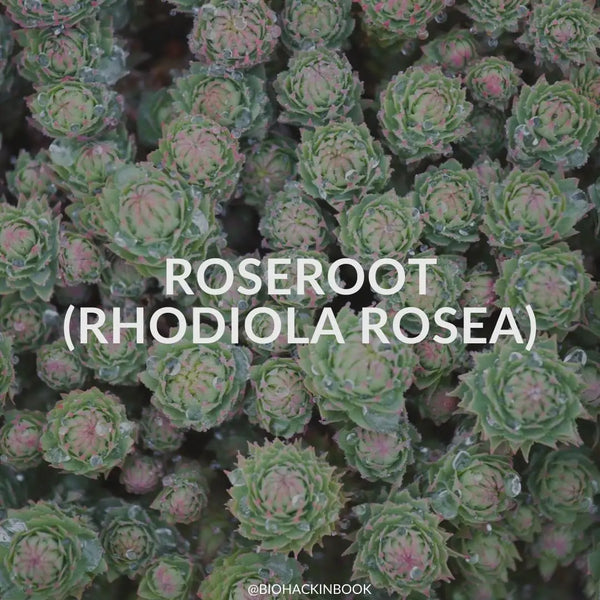
Roseroot is one of the oldest herbaceous plants in the world. It belongs to the genus sedum and grows especially in the northern hemisphere. Roseroot has a long history of use in challenging conditions such as the Tibetan mountains, the Siberian desert, and cold Scandinavia. The Vikings have been reported to have used roseroot to improve physical strength and endurance.
Roseroot has traditionally been used, among other things, to prevent diseases during cold and humid winters in Siberia and to improve blood circulation and increase energy in Tibet. About 2000 years ago, the famous Greek physician Dioscorides (c. 40-90) mentioned the roseroot (Rodia Riza) in his book De Materia Medica. Roseroot was also found in the Swedish Pharmacopoeia as early as 1755. Roseroot is also called the Arctic root.
The stress-relieving properties of roseroot are based on rosavin and salidroside, among others. However, almost 140 active ingredients have been isolated from roseroot. Based on tissue and cell culture studies, they are estimated to have a wide variety of effects. These include neuroprotection and cardioprotection, reduction of fatigue and exhaustion, alleviation of anxiety and depression, cognitive support properties, and central nervous system stimulating effects.
Roseroot salidroside can protect nerve cells from damage and in particular from the so-called excitotoxicity – a condition in which nerve cells are over-activated, for example by excessive glutamate. Studies with nematodes and flies have shown that roseroot prolongs at least the lifespan of these organisms.
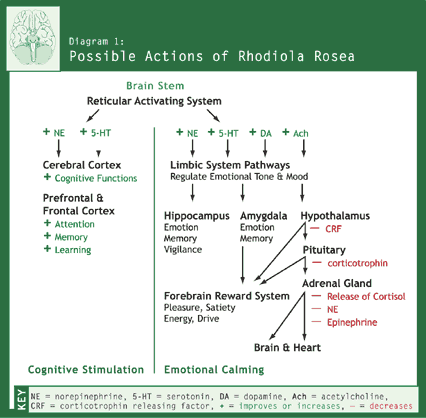
Source: Brown, R. & Gerbarg, P. & Ramazanov, Z. (2002). Rhodiola rosea: A Phytomedicinal Overview. HerbalGram 56: 40–52.
The most bioactive ingredients of roseroot are p-tyrosol and its glycoside salidroside. Besides, rosavin is thought to have physiological effects. Studies in humans with SHR-5 extract (standardized 4: 1 alcohol extract from roseroot) have shown beneficial effects on, for example, stress management when studying intensively, stress management and fatigue in knowledge work, and cognitive performance during the night shift.
Roseroot has numerous physiological mechanisms of action in the body. These are presented in more detail in the diagram above. The main mechanisms of action are related to the regulation of the neurotransmitter balance in the brain, the production of energy by muscle cells, the secretion of stress hormones, and the prevention of oxidative stress. Based on human studies, roseroot is safe to use and no clinically significant side effects have been reported.
For an absolutely functional kick with coffee & lion's mane combined with rhodiola, check out this!
2. Ashwagandha (WIthania somnifera)
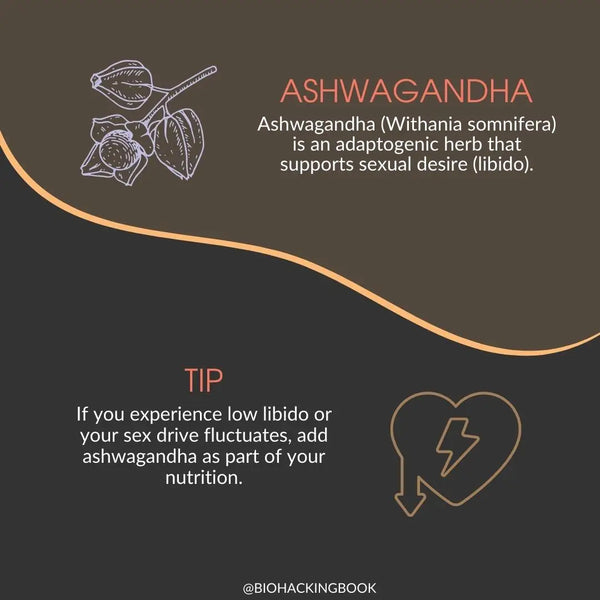
Ashwagandha has been used in Ayurvedic medicine for several thousand years, especially in Tibet. The name ashwagandha means “horse smell,” which refers to a fresh root smell resembling a horse. The story goes that using ashwagandha can achieve horse strength and virility.
Ashwagandha is generally classified in Ayurveda as a Rasayana herb that strengthens and rejuvenates. Ashwagandha is also known as 'Indian ginseng', which is explained by the abundant cultivation of the root in India. Ashwagandha is used as a dried herb (roots and leaves), as a liquid extract, and as a standardized extract.
The main biochemically active ingredients in Ashwagandha are so-called steroidal lactones such as withaferin A, withanone, withanoside IV, and withanolide A. Three standardized new preparations are available from Ashwagandha: the broad-spectrum KSM-66, the more sedative Sensoril and a super potent micro-encapsulated Shoden.
Numerous clinically relevant studies based on human experiments have been published on Ashwagandha. Beneficial health effects have been observed in the prevention of anxiety, reduction of stress levels, and treatment of stress-related depression. Ashwagandha has also been found to significantly reduce cortisol levels.
Based on mouse experiments, it can prevent stress-induced weakening of the immune system. Ashwagandha can significantly improve physical performance (strength, oxygen uptake, and recovery) and slightly increase testosterone levels and help elevate sexual performance in men (shoden ashwagandha, in particular).
Ashwagandha may also add sexual desire in women and fertility in men. Based on experiments done on mice, ashwagandha can also help with insomnia and may accelerate falling asleep. The mechanism that supports falling asleep and sleep in general is explained by the sedative effect via GABA receptors. Studies in mice suggest that ashwagandha may be as effective in helping obsessive-compulsive disorder (OCD) as SSRI drug fluoxetine.
The use of Ashwagandha is generally classified as safe and no side effects have been reported. Intestinal irritation may occur at higher single doses. The use of Ashwagandha is not recommended in combination with MAO inhibitors.
3. Reishi (Ganoderma lucidum)
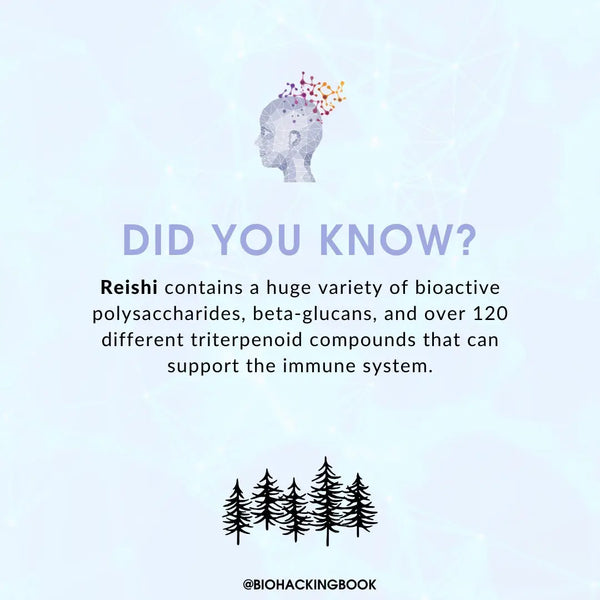
Reishi has been used for millennia as a reliever for coughs and asthma, as a sedative for the mind, and as a relief for dizziness, insomnia, and anxiety, especially in Chinese medicine. Reishi’s medicinal history extends to about 2,500 years back in time, when it was used mainly in royal and wealthy circles. According to legend, China's first emperor sent explorers to seek the elixir of life in the eastern islands (the territory of present-day Japan). Explorers who returned years later brought reishi.
Reishi is said to sustain life, increase life expectancy, promote health, and balance body functions without side effects. It is thought to increase the so-called shen, which in Chinese medicine is the channel of spirituality – the connection between heart and mind.
Reishi grows in nature in six different types that are thought to have different effects. Red Reishi, or Ganoderma lucidum, is the most studied of these and has the strongest medicinal effects. Reishi is also known as Lingzhi, the “10,000-year-old mushroom,” the “immortality mushroom,” and “the elixir of life.” Extremely beautiful in appearance, reishi is wild in nature, a relatively rare sight. For this reason, it is now grown using organic dark rice or logs as a growing medium.
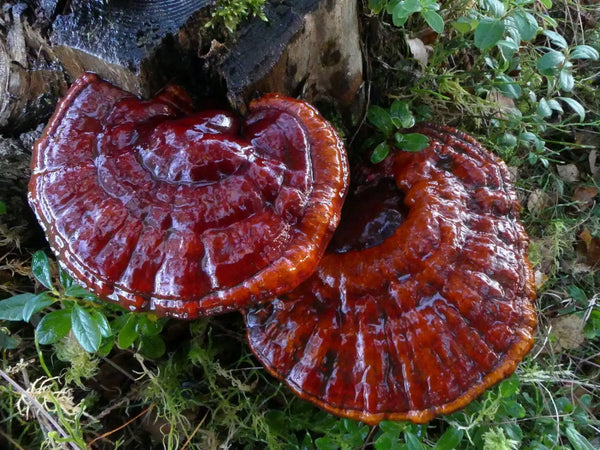
Image: Wild reishi growing in Finland.
Source: eskonkuvat.kuvat.fi
In Finland, reishi grows in lush beach groves and alder swamps. The host trees are deciduous stands of deciduous alders or decaying trunks, and sometimes decay birches or spruces. Reishi is found all over the world: in Asia and North America, as well as in the tropics and Central Europe.
Reishi is generally considered the king of adaptogenic herbs. At least sterols (ergosterol, coumarin, mannitol), polysaccharides (ganoderans B and C, beta 1,3-D-glucopyranose, beta-glucans), more than 100 known triterpenoids (Ganoderma acids), germanium, and several vitamins are known as active ingredients of reishi. Triterpenoids are recovered especially by an alcohol extract. Correspondingly, polysaccharides are well extracted in water. Today, double extracts (water and alcohol) are available, which contain most of the bioactive substances in reishi.
The ingredients in reishi act on the cells that regulate the immune system. Reishi can either stimulate or silence the immune system – it balances and teaches cells to adapt to the responses created by the environment. Because of these properties, Reishi acts as an immunomodulator.
Based on studies in rats, reishi helps to reduce excessive stress by relaxing and making it easier to fall asleep and increasing the amount of sleep. In addition, it has been shown to possess protective effects against various toxins (studies done on mice). Reishi has also been found to significantly relieve fatigue in fatigue syndrome or neurasthenia.
Reishi is not generally recommended for people with autoimmune diseases because of its potential to stimulate the immune system. Reishi may also block the action of medicines that affect the immune system, for example in the treatment of cancer. If you are considering using reishi in these conditions, it is recommended that you discuss this with your doctor first.
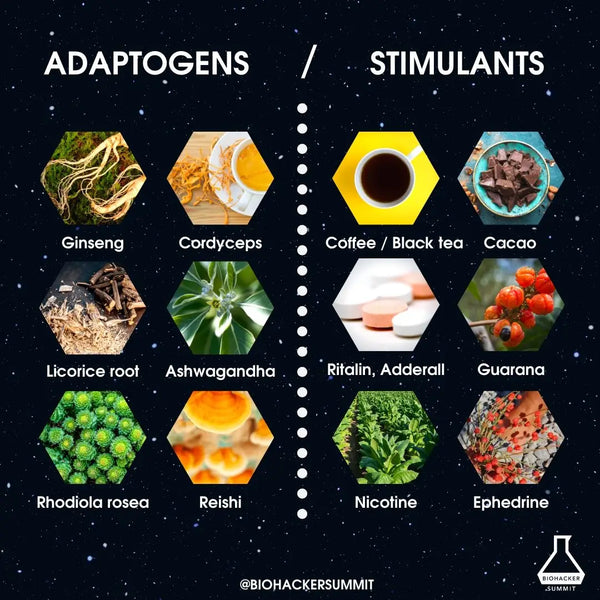
4. Ginseng (Panax ginseng)
Panax ginseng, or just ginseng, is one of the best-known and most used herbs around the world. The historical origin of ginseng extends to East Asia, especially Korea. That is why ginseng is also often called Asian ginseng or Korean red ginseng. Korean red ginseng is steamed and then dried panax ginseng. These differ in the number and species of ginsenosides.
Etymologically, the name ginseng is derived from the Chinese words gin, which means human, and sen which means tart. Indeed, ginseng resembles a human in shape and tastes sour. The word panax is similarly derived from the Greek language - panakés or pan means everything and akos healing.
The root part of the ginseng plant is used when the plant has grown to 5–12 years of age. The older the plant, the more it concentrates various biochemically active ingredients at its roots. There are more than 100 different ingredients in ginseng – the most bioactive are various ginsenosides, such as Rg3, the most important ginsenoside of Korean ginseng.
The standardized ginseng extract contains 2-3 % ginsenosides. The typical dose of Panax ginseng is 200 to 400 mg per day. The dosage of Korean red ginseng to improve libido and genital circulation is 1000 mg three times a day. The patented G115 Panax ginseng for medical use contains 4 % ginsenosides. Similarly, another patented ginseng extract, NAGE, contains 10 % ginsenosides.
Panax ginseng is by far the most studied adaptogenic herb. The health effects of ginseng are quite extensive which are based on human studies. Ginseng has been shown to significantly help control blood sugar (including in type 2 diabetics), improve cognitive function, help treat erectile dysfunction (see above), increase overall well-being, and help with fatigue. Korean red ginseng can also help lower blood pressure with temporarily high blood pressure and hypertension.
Based on studies in rats, ginseng also has stress-relieving effects. It affects, among other things, the biosynthesis of catecholamines, and may be useful when used regularly in the treatment of chronic stress. Ginseng is generally safe to use at normal therapeutic dosages. For some people, ginseng can cause hypoglycemia (low blood sugar).
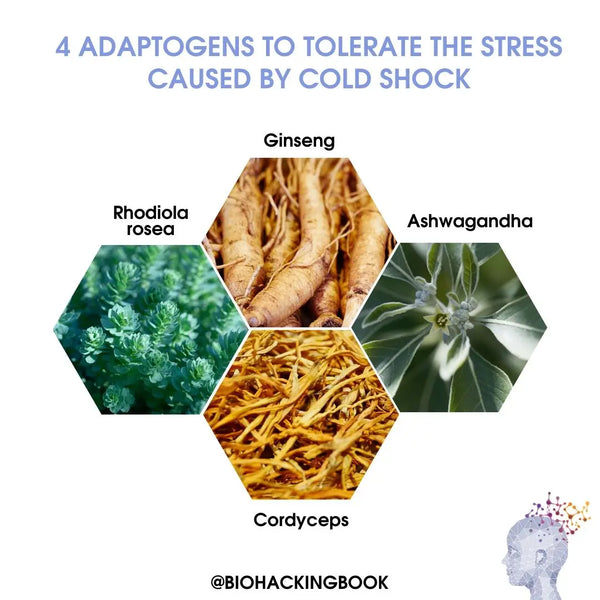
Check out amazing London adaptogenics Mojo Coffee with cordyceps & ginseng!
5. Cordyceps or Caterpillar fungus (Ophiocordyceps sinensis)
Cordyceps is a genus of fungi that live as parasites and includes about 400 different varieties. The best known of these is Cordyceps sinensis, whose name was corrected to Ophiocordyceps sinensis a few years ago as a result of DNA analysis. In Tibetan and Chinese medicine, Cordyceps is one of the most prized herbs of all and has been used especially to support kidney and lung function and restore overall vitality.
Growing wild, Cordyceps is one of the most expensive herbs in the world, and its price per kilo can be as high as 30,000 euros. The fungus has become rarer year by year as a result of its excessive harvesting. Virtually all of the Cordyceps sold worldwide are cultivated. For example in Finland, there are at least 10 different varieties of cordyceps such as Cordyceps ophioglossoides parasites on tuberous fungi growing in the ground. Cordyceps militaris, on the other hand, parasitizes in butterfly larvae and butterflies. These cordyceps varieties have also been studied relatively extensively in the light of their medicinal properties.
The main active ingredients of Cordyceps are cordycepin (an adenosine derivative), ergosterol, cordymine (an antifungal peptide), and various bioactive polysaccharides. Relatively few studies in humans have been published on Cordyceps. According to one placebo-controlled double-blind study, Cordyceps sinensis (Cs-4 variety) significantly increases oxygen uptake and lactic acid tolerance in individuals aged 50 to 75 years. The use of cordyceps in young endurance athletes has not been shown to benefit in improving endurance.
Based on experiments in rats, Cordyceps increases skeletal muscle metabolism, vascular remodeling (angiogenesis), improves glucose and lactate uptake, and acts as an antioxidant. In addition, rat studies have shown that the use of cordyceps slows fatigue in exhaustive situations and increases stress tolerance, and stimulates testosterone synthesis in the testes. Cordyceps has also been found to slow aging in mice.
Cordyceps is generally considered safe to use and no side effects have been reported.
///





